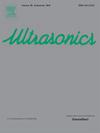基于拓扑电荷的声涡旋阱尺度
IF 3.8
2区 物理与天体物理
Q1 ACOUSTICS
引用次数: 0
摘要
通过利用超表面和换能器阵列的实验研究,证明了利用声学涡流捕获Mie粒子的三维效果。虽然广泛的分析和数值研究已经探索了涡旋光束的性质和尺寸,但对聚焦涡旋拓扑电荷对陷阱尺寸、稳定性和位置的依赖关系的全面研究仍然缺乏。本文对平面波换能器所产生的聚焦涡旋粒子捕获进行了解析、数值和实验分析。我们的研究结果揭示了陷阱大小对拓扑电荷的强烈线性依赖,与先前在高斯和光学涡旋光束中观察到的趋势一致。这一发现在实验中得到了验证,使用压电传感器和定制的硅胶透镜来产生聚焦的涡流光束,成功地将不同大小的聚合物颗粒捕获在充满水的腔室中。此外,数值和实验数据证实了分析预测,即增加光束的拓扑电荷使陷阱位置更靠近声源。这些结果建立了声学捕获应用的关键设计原则,特别是在生物医学和粒子操纵技术中。本文章由计算机程序翻译,如有差异,请以英文原文为准。
Scaling acoustic vortex traps with topological charge
Three-dimensional trapping of Mie particles using acoustic vortices has been demonstrated through experimental studies leveraging metasurfaces and transducer arrays. While extensive analytical and numerical studies have explored the properties and dimensions of vortex beams, a comprehensive investigation into the dependence of trap size, stability, and positioning on the focused vortex’s topological charge remains lacking. This study presents an analytical, numerical, and experimental analysis of focused vortex particle trapping generated by a plane wave transducer equipped with a phase-modifying metalens. Our results reveal a strong linear dependence of the trap size on the topological charge, aligning with trends previously observed for Gaussian and optical vortex beams. This finding is experimentally validated using a piezoelectric transducer and a custom silicone lens to generate focused vortex beams, successfully trapping polymer particles of varying sizes in a water-filled chamber. Additionally, numerical and experimental data confirm the analytical prediction that increasing the beam’s topological charge shifts the trap position closer to the acoustic source. These results establish crucial design principles for acoustic trapping applications, particularly in biomedical and particle manipulation technologies.
求助全文
通过发布文献求助,成功后即可免费获取论文全文。
去求助
来源期刊

Ultrasonics
医学-核医学
CiteScore
7.60
自引率
19.00%
发文量
186
审稿时长
3.9 months
期刊介绍:
Ultrasonics is the only internationally established journal which covers the entire field of ultrasound research and technology and all its many applications. Ultrasonics contains a variety of sections to keep readers fully informed and up-to-date on the whole spectrum of research and development throughout the world. Ultrasonics publishes papers of exceptional quality and of relevance to both academia and industry. Manuscripts in which ultrasonics is a central issue and not simply an incidental tool or minor issue, are welcomed.
As well as top quality original research papers and review articles by world renowned experts, Ultrasonics also regularly features short communications, a calendar of forthcoming events and special issues dedicated to topical subjects.
 求助内容:
求助内容: 应助结果提醒方式:
应助结果提醒方式:


